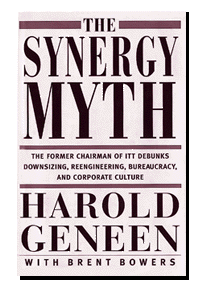The Synergy Myth: And Other Ailments of Business Today by Harold Geneen, with Brent Bowers
The Synergy Myth: And Other Ailments of Business Today by Harold Gennen, with Brent Bowers (248 pages, St. Martin's Press, 1997)
(originally published by Booz & Company) You have to admire someone who, after spending his whole life doing business, was still at it at age 87, not for the money but for the sheer pleasure of the transaction. Harold Geneen, the legendary former chairman of ITT, worked on The Synergy Myth: And Other Ailments of Business Today, shortly before his death in November 1997. But the book is no funerary last will and autobiography. Mr. Geneen was a curmudgeon on steroids, but a pragmatic one. He had no patience for the modern corporation and its pallid, risk-averse leadership, paring back to "core" businesses and gussying up internal affairs with folderol management theories. When the word "synergy," or any other consultant jargon, comes up, Mr. Geneen's contempt explodes off the page and sets the reader's chair on fire. "One thing I won't defend," he wrote in his introduction, "is a carcinogenic slice of baloney called 'synergy.'" This is an early hint that Mr. Geneen was an elder stateman with a sense of fun.
You have to admire someone who, after spending his whole life doing business, was still at it at age 87, not for the money but for the sheer pleasure of the transaction. Harold Geneen, the legendary former chairman of ITT, worked on The Synergy Myth: And Other Ailments of Business Today, shortly before his death in November 1997. But the book is no funerary last will and autobiography. Mr. Geneen was a curmudgeon on steroids, but a pragmatic one. He had no patience for the modern corporation and its pallid, risk-averse leadership, paring back to "core" businesses and gussying up internal affairs with folderol management theories. When the word "synergy," or any other consultant jargon, comes up, Mr. Geneen's contempt explodes off the page and sets the reader's chair on fire. "One thing I won't defend," he wrote in his introduction, "is a carcinogenic slice of baloney called 'synergy.'" This is an early hint that Mr. Geneen was an elder stateman with a sense of fun.
Mr. Geneen, of course, bestrode the corporate world back when men were men, M.B.A.s were rare and the conglomerate was the highest expression of capitalism. In 1959, he assumed command of what was then the International Telephone & Telegraph Company and later came to be called the ITT Corporation. The company was adrift, with 136,000 employees around the world but no centralized leadership. Mr. Geneen's main problem, he realized, was that 85 percent of his shareholders were American while 90 percent of his assets were abroad; in the United States ITT owned only a small military company and a telephone equipment outfit that supplied outdated technology. Abroad, however, ITT owned eight telephone operating companies and dozens of manufacturing subsidiaries and suppliers. The company was much bigger than anyone in the United States, particularly on Wall Street, realized.
A person with less vision than Mr. Geneen might have seen trouble on the horizon from the antitrust police, but that is getting ahead of the story, which, sketchy though it is in The Synergy Myth, is fascinating. Mr. Geneen needed to fit the farflung company's disparate pieces — there were 50 companies in Europe alone — together into a coherent whole. That meant dealing with such issues as political instability in Brazil and the many lingering enmities from World War II. He set up shop in Belgium, mainly because the Belgians loathed everyone else equally and the country therefore was neutral ground.
It was not Mr. Geneen's purpose in his book to tell a history of ITT's rebound. He promised his troops to deliver quarterly 10 percent growth and did, apparently, for 50 consecutive quarters. Of the early days, there is little detail. The Synergy Myth really, in a sense, an editorial in which Mr. Geneen comes across as a committed member of the conglomerati, even if he was not technically still in that fray. He saw no more commonsensical way to contend with the complexities of the modern world than by acquiring companies with growth potential and helping them grow. ITT had two criteria for its acquisitions: was the market worth going after? And, could ITT "improve the company's product, expand its market and increase its profit?" ITT executives did not agonize about fit or synergies; companies that do so, Mr. Geneen contended, were just trying to find a complementary strength for a weakness. "The secret of the conglomerate is simple," he wrote. "It's a network of resources that you can use where you need them. The most important resource is human — managers trained to solve problems."

The secret of the conglomerate does not sound so far afield from what is now referred to as human capital — the notion that employees are one of a company's most important resources. Mr. Geneen wrote that he believed in employee empowerment long before "empowerment" became the next new thing. He began by empowering himself: he took jobs for the opportunities and challenges they provided and he did not stay long at a company that seemed not to share his own high opinion of himself. Wanting a safe, stable livelihood, he took college courses in accounting, but he was not by temperament cautious. Even in his 80s, he said he took his own best advice: "Go ahead. Jump!"
Mr. Geneen claims he always encouraged his employees to take risks and reap the benefits, for self and company. He himself intimated that ITT was not always a happy place to work. There was said to be an ITT look, geeky, regimented and buttoned-down, in the mode of other large corporations such as the International Business Machines Corporation, that Mr. Geneen enforced with cultish enthusiasm though in his book he does not remember it quite that way. Similarly, Mr. Geneen polishes off the Government's breakup of ITT in a few paragraphs and hardly pauses to troll through the conglomerate's detritus. And yet how can anyone of a certain age fail to remember when Dita Beard, ITT's lobbyist, had her 15 minutes of shame, and Henry Kissinger was the company's back-channel guy?
By the end of The Synergy Myth, the curmudgeonly side of Mr. Geneen throughly overwhelms the commonsense, so much so that the reader is left to pore over his picture on the book jacket, wondering if somehow Newt Gingrich could have taken up residence behind those elfin features somewhere about two-thirds of the way through. The book morphs into a screed against government regulations, environmentalists, animal rights advocates, socially responsible investors, civil servants, litigious consumers, and naturally enough, antitrust laws. There is no reason to linger over such murk. Thumb back instead to the pronuncements against "synergy" and the declaration that all messianic rhetoric involving the words "information superhighway" should be banned — curmudgiana for the rest of us! ![]()

